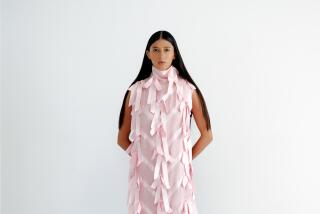Eastern lore, Western allure
IN period films, costume designers wrestle with the sticky problem of making historical accuracy and theatricality compatible. To create the costumes for “Memoirs of a Geisha,” Academy Award-winning designer Colleen Atwood also had to understand and portray an exacting culture.
“In Japan, there are rules for everything,” she says, “so what you wear in a particular season is very well-defined.”
For the record:
12:00 a.m. Nov. 18, 2005 For The Record
Los Angeles Times Friday November 18, 2005 Home Edition Main News Part A Page 2 National Desk 1 inches; 44 words Type of Material: Correction
“Memoirs of a Geisha” -- An article in the Nov. 6 Calendar section about creating the wardrobe for the movie “Memoirs of a Geisha” credited sketches of costumes as courtesy of Colleen Atwood. Atwood designed the costumes, but the sketch artist was Felipe Sanchez.
For The Record
Los Angeles Times Sunday November 20, 2005 Home Edition Sunday Calendar Part E Page 2 Calendar Desk 1 inches; 37 words Type of Material: Correction
“Memoirs of a Geisha” sketches -- Sketches of costumes designed for “Memoirs of a Geisha” were incorrectly credited on Nov. 6 as courtesy of Colleen Atwood. Atwood designed the costumes, but the sketch artist was Felipe Sanchez.
For months before production began on the film, which is based on the bestselling 1997 novel by Arthur Golden and which opens Dec. 9, Atwood flung herself into research. She pored over archival photos from the 1920s through the 1950s, studied esoteric textile techniques and became conversant with rules for proper dress -- the Japanese equivalent of not wearing white after Labor Day.
“There’s no such thing as getting it all right,” she says. “Everybody has a different idea about what’s right and what’s wrong, and what pleases some people doesn’t please others. Luckily, I had a few advisors who had a sense of humor and said, ‘Just do it.’ ”
Doing it, designing costumes for dozens of principals and hundreds of extras, required taking artistic license. For example, Atwood concluded that the subtlety of actual geisha dress wouldn’t have the right impact on film.
“We were taking an art form that is a huge part of Japanese culture, but it was important to remember that we were making a movie, based on a book of fiction, written by a guy, about a geisha,” Atwood says. “It’s not a documentary film. I’d worked with [director] Rob Marshall before on ‘Chicago.’ His vision was that this movie is a grand story about a woman’s life, a sort of ‘Gone With the Wind’ set in another time and place. His vision freed all of us to create a theatrical world together.” (Marshall’s approach was reflected in the casting of the film, which created a flurry by awarding the key roles to Chinese actresses.)
A kimono might seem to be a simple garment, 8 yards of fabric that’s wrapped around the body. But Atwood discovered it could take a lifetime to really become knowledgeable about the intricacies of the kimono. “What creates value are all the layers of technique involved in the fabric,” she says. “A high-end kimono has hand painting and shibori, a very specific dyeing technique, as well as hand embroidery and a hand-woven obi. In Japan, it takes about a year to make one.”
With a crew of 30 and embroiderers working in three countries, Atwood had to figure out ways to fast-track kimono production, creating traditional effects with modern methods. She worked on “Memoirs of a Geisha” for nine months and had to dress six central female characters and as many as 200 extras some days. She also created wardrobes for the men in the story. Some antique kimonos were rented from collectors in Japan, a number of others were constructed from vintage cloth, and classic patterns were reproduced on new materials. Motifs recur -- goldfish, hummingbirds, chrysanthemum, dogwood, wisteria, snowflakes and waves -- although some are worn only during certain seasons.
Atwood thinks audiences will respond to the femininity of the costumes and the beauty of the fabrics used, but she acknowledges that what the Japanese consider sexy is different from the Western ideal. “The whole idea is to have mystery,” she says. “It’s all about hidden treasures.”
With kimonos wrapped high and tight, even a glimpse of wrist bone can be enticing. Sayuri, the lead character, wears a warm, golden kimono embroidered with maple leaves for a pivotal encounter with the great love of her life. The neckline dips gracefully away from the back of her neck, revealing a smooth, serene expanse of flesh between the shoulder blades, an underexposed area fashion designers may be inspired to highlight in future collections.
The silhouette of a kimono fastened with a thick obi is barrel-like; it pads and obscures the body. Atwood altered the costumes slightly to create a shape more palatable to modern audiences. “We wanted to see a shoulder, to have the illusion of a waist and have a sense of breasts beneath the kimono,” she says. “We were trying to honor the form but make it more accessible, so we made the obi fit tight against the body to sort of glam it up.”
In a story rich with drama, history and romance, there must be room for a judicious dose of Hollywood glamour.
More to Read
Only good movies
Get the Indie Focus newsletter, Mark Olsen's weekly guide to the world of cinema.
You may occasionally receive promotional content from the Los Angeles Times.










